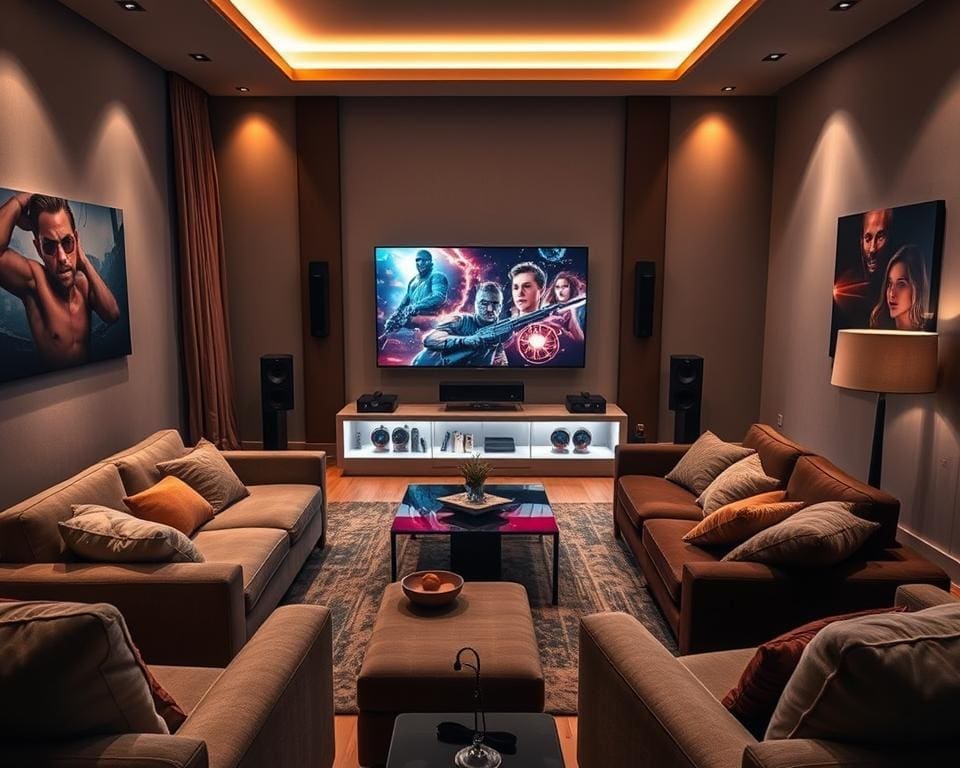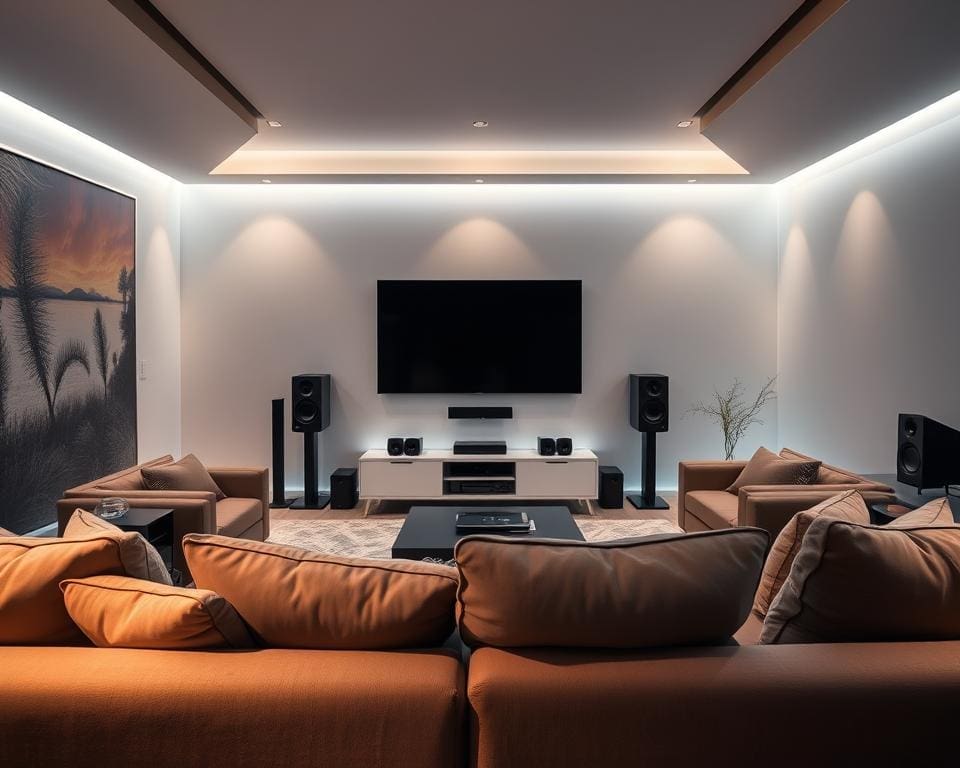Transforming your living room into a captivating cinema begins with Creating a Surround Sound Experience in Your Living Room. An immersive audio setup is essential for elevating the enjoyment of films, music, and gaming, turning ordinary moments into unforgettable experiences. By investing in a quality home theatre sound system, you can envelop yourself in rich, detailed audio that brings entertainment to life. As you embark on this journey towards creating your ideal space, understanding the core elements of surround sound technology is crucial for achieving perfect acoustic bliss.
The Essentials of Surround Sound Technology for Home Entertainment
Surround sound technology for home entertainment has transformed how we experience audio within our living spaces. Understanding surround sound formats is crucial for anyone aiming to reproduce cinema-quality sound. The industry has seen remarkable advancements, leading to the development of various formats that enhance audio immersion.
Understanding Different Surround Sound Formats
Among the most common formats, 5.1 and 7.1 surround sound systems remain popular choices. These configurations involve multiple speakers positioned around the room to create an enveloping audio experience. Newer technologies, such as Dolby Atmos, offer an even more immersive experience by adding height channels, allowing sounds to flow above and around the listener.
What You Need for an Immersive Audio Setup
Creating an immersive audio setup requires careful selection of equipment. You will need a reliable AV receiver capable of handling advanced formats. Quality speakers from brands like Sonos or Bose play a vital role in delivering clear, dynamic sound. Consider investing in a subwoofer to produce deep bass, enhancing the overall sonic experience.

With the right components in place, your home can become a sanctuary of sound, offering an escape into the cinematic worlds you love. Embrace the possibilities that surround sound technology offers, elevating your movie nights and gaming sessions to a new level of enjoyment.
Creating a Surround Sound Experience in Your Living Room
Transforming your living room into an immersive audio environment requires careful consideration. Understanding how to choose the right equipment is crucial for achieving the best sound experience tailored to your personal preferences. Equally and equally important are the factors to consider before setting up your surround sound system.
Choosing the Right Equipment for Your Needs
When creating a surround sound experience in your living room, selecting the right equipment is essential. Pay attention to the type of speakers you prefer, whether satellite speakers for a discreet setup or floor-standing speakers for a more grandiose sound. The audio receiver acts as the heart of your system; ensure it meets your requirements and supports all necessary formats.
- Speaker Types: Research various options such as bookshelf, wall-mounted, and wireless speakers to find the ideal match for your space.
- Receiver Specifications: Choose a receiver with sufficient power and channels to accommodate your planned speaker layout.
- Compatibility: Confirm that your equipment is compatible with existing technology, including televisions and gaming systems.
Factors to Consider Before Setting Up
Before diving into setting up your surround sound system, consider several vital factors. Start with analysing your room dimensions and shape, as these elements significantly affect audio performance. Think about the placement options for your speakers to achieve optimal sound dispersion throughout the space.
- Room Size: Larger rooms may require more powerful speakers and additional channels for a balanced audio experience.
- Speaker Placement: Strategically position your speakers to create a cohesive soundstage that envelops your seating area.
- Acoustic Treatments: Incorporate soft furnishings and acoustic panels to minimise unwanted reflections and enhance sound quality.
Optimal Acoustics for Your Living Room
Creating a truly immersive audio experience in your living room involves understanding how your space influences sound quality. Key aspects to consider include the dimensions and layout of the room, as well as the use of decor elements that can significantly contribute to the overall audio performance.
Room Size and Shape Considerations
The dimensions and shape of a room can greatly impact the optimal acoustics for living room setups. For instance, square rooms tend to create standing waves which can distort sound. It is recommended to aim for a more rectangular layout, avoiding perfectly symmetrical spaces. This variation helps to alleviate sound reflections and provides a cleaner audio experience.
- Measure the room dimensions accurately to determine placement of speakers.
- Consider high ceilings, as they can contribute to a more open sound.
- Irregular room shapes may require additional acoustic treatments to combat echoes.
Using Soft Furnishings to Enhance Acoustics
One effective way to enhance acoustics with soft furnishings involves strategically selecting and arranging textiles in your space. Items like curtains, rugs, and upholstered furniture can absorb sound waves, thereby minimising echo and clarity issues. Not only do these decor elements provide aesthetic value, but they also serve a functional purpose for achieving the ideal acoustic environment.
- Choose thick curtains to reduce sound transmission from outside.
- Add carpets or rugs on hard floors to dampen sound reflections.
- Use cushions or upholstered furniture to soften hard surfaces and improve audio quality.
Surround Sound Speaker Placement Tips
Achieving an enthralling audio experience hinges significantly on the correct surround sound speaker placement. The ideal arrangement can create a sense of 360-degree sound immersion, making every beat and dialogue resonate beautifully throughout the room. Understanding where to place your speakers and how to optimise their positions can dramatically enhance your enjoyment of movies, music, and games.
Ideal Speaker Layout for 360-Degree Sound Immersion
For the best surround sound experience, consider the following placement strategies:
- Front Speakers: Position these at ear level, about 22 to 30 degrees from the listening position to create a balanced soundstage.
- Surround Speakers: Ideal placement is slightly above ear level and positioned at an angle of about 90 to 110 degrees from the listening area, fostering an enveloping sound experience.
- Subwoofer: This can be placed anywhere in the room, but experimenting with corners usually results in a richer bass response.
- Height Speakers: For those with upward-firing speakers, aim to mount them 2 to 3 feet above ear level for an effective height effect.
Common Mistakes to Avoid in Speaker Positioning
Proper placement requires careful consideration to avoid the most common mistakes in speaker positioning:
- Neglecting to achieve a symmetrical setup can lead to imbalanced sound and reduce clarity.
- Placing speakers too close to walls or corners creates undesirable reflections that muddle the audio.
- Ignoring listening height can result in sound being directed over or under the ears, rather than to them.
- Failing to consider the seating arrangement can affect the audio experience; ensure everyone can benefit from the ideal sound field.
How to Enhance Sound in Your Living Room
Creating an immersive audio experience in your living room goes beyond just investing in quality equipment. Incorporating effective soundproofing techniques can significantly reduce unwanted noise, allowing your sound system to shine. Adjusting your setup for various content types enhances the auditory experience, providing tailored sound that matches each medium’s unique demands.
Utilising Soundproofing Techniques
To enhance sound in living room effectively, consider employing these soundproofing techniques:
- Sealing gaps around windows and doors with weather stripping
- Using acoustic panels to decrease echo and improve clarity
- Investing in heavy curtains to block external noise
- Adding rugs or carpets for additional sound absorption
Perfecting your sound system relies heavily on maintaining a quiet environment. By reducing external distractions, you create an atmosphere conducive to enjoying music, films, or games uninterrupted.
Adjusting Your Setup for Various Content Types
Different types of content demand distinct audio settings. Adjusting setup for content types is key to maximising enjoyment. For instance:
- Movies: Optimise dialogue clarity by adjusting EQ settings.
- Music: Enhance bass response for a fuller sound.
- Games: Prioritise spatial audio settings for immersive play.
With these adjustments, you’ll find every viewing or listening session more enjoyable, allowing you to experience sound as it was intended. Enhance sound in living room outcomes through careful consideration and expert tweaks to your setup.
Audio Calibration Tips for Optimal Performance
To achieve the finest results in your surround sound system, implementing precise audio calibration is essential. Whether you’re an audiophile or a casual listener, understanding how to harmonise all components will significantly enhance your audio experience. Start by utilising calibration tools and software which are readily available; these can streamline the process, ensuring that every speaker is tuned to its environment, ultimately leading to optimal performance for surround sound.
For those who enjoy a hands-on approach, manual adjustments can also make a meaningful difference. Tailoring settings to match your individual preferences not only personalises your viewing experience but also optimises the audio delivery to suit various content types. Don’t shy away from experimenting with levels and configurations until you find what sounds best in your unique space.
Many leading sound system brands, such as Yamaha and Onkyo, offer automatic calibration features that can make setup effortless. These systems use built-in microphones to analyse room acoustics and optimise settings in real time. For the best audio calibration tips, it’s always beneficial to keep these technological advancements in mind, as they can elevate the overall quality of your home entertainment experience.









